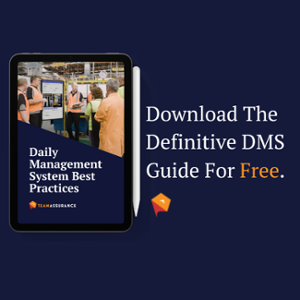Hoshin Kanri: Linking the Top to the Bottom

Paul Dunlop explains how Hoshin Kanri, supported by adjacent Lean processes, facilitates effective strategy planning, deployment and execution.
A prerequisite for long term, sustainable success in any organisation is the ability to formulate and execute a well thought out strategy.
The strategy acts as the rudder of the ship; keeping it on course as the vessel negotiates ever changing conditions and environmental circumstances. The rudder, like a steering wheel ,should point in the desired direction.
It should also provide good quality feedback to the driver enabling them to assess the inputs to adjust, change, or stay the course as required.
Strategy Deployment is a Team Sport
 Great strategic outcomes and achieving long term, repeatable success is a team sport. It requires everyone, at every level, to be clear, committed and actively engaged. Everyone must be involved in sharing and growing their knowledge.
Great strategic outcomes and achieving long term, repeatable success is a team sport. It requires everyone, at every level, to be clear, committed and actively engaged. Everyone must be involved in sharing and growing their knowledge.
When developing our strategic plans, employees and teams at all levels of the organisation should be included and collaborating. This comes back to the core Lean tenet 'respect for people' whereby the key insights and ideas for improvement are not solely the domain of management staff.
In fact, commitment and understanding throughout the organisation will be built through clarity, inclusion and active participation in the process. This is best delivered through a Daily Management System.
This situation demands that employees have access to good quality, clear, and up-to-date information. This ensures there is genuine openness in the way information is shared, disseminated and linked up and down a tiered structure.
This strategy deployment process is typically known as Hoshin Kanri (or Hoshin Planning).
The Power of Hoshin Kanri
Hoshin planning is not only about setting and managing longer term objectives. It is also focussed on the alignment of people, process and activity (vertically and horizontally) throughout the organisation toward those goals.
Alignment is the key to successful strategic deployment and activity. We need everyone in the organisation to be clear and on board with the plan / direction.
Without this we inhabit a world where we are stuck in the reactive weeds of the day to day. We end up with a myopic view of improvement or have misaligned initiatives. This takes the organisation - and it’s component parts - in directions that are contrary to each other. We stray from what the organisation really needs or where we want to be.
How do Hoshin Kanri, PDCA and Daily Management Fit Together?
Ultimately Hoshin planning is bigger picture PDCA (Plan Do Check Act) activity. The essence of Hoshin is that it is has laser focussed clarity. It is simple to interpret and execute, and it is flexible and agile to the organisation’s needs like all Lean tools are intended to be.

The management of a Hoshin plan like daily management should be clear, simple and visual. It should be broken down to component parts and woven into the DNA of daily activity through our tiered DMS structure. The key focus points and activity on an hour to hour, day to day basis should directly link to the annual objectives.
Hoshin elements are typically broken down into quarterly cycles and further broken down into fortnightly review / touchpoints. This approach should cascade through the layers of management and function right down to team and individual objectives.

Following PDCA methodology, this approach again facilitates a clear focus on what is important now. It also provides a mechanism for continuous feedback, adjustment, and reflection on the strategic focus. It is enables us to understand what the organisation “should” do, not what it “can” or “could” do. From here we can act in a decisive and intentional way rather than simply reacting blindly in the moment.
Hoshin Kanri Supports Optimisation of the Greater C.I. Framework
For effective strategy deployment we must ensure that all our adjacent processes are focused on alignment of all the people, processes and systems involved. Lean tools like standardised problem solving techniques, documentation, A3 Templates, and a Tiered Daily Management process that supports the entire PDCA loop are key to achieving success.
The image below demonstrates how the interconnected TeamAssurance platform is designed to avoid locally optimised, disconnected ‘Point Solutions’ (digital or analog) that do not help, and may even hinder your organisation’s strategy deployment goals.

If you’re a business in need (or a consultant with clients in need) and you'd like to explore the opportunities that digital-aids to Lean tools provide contact us for a demonstration of the TeamAssurance platform today.


